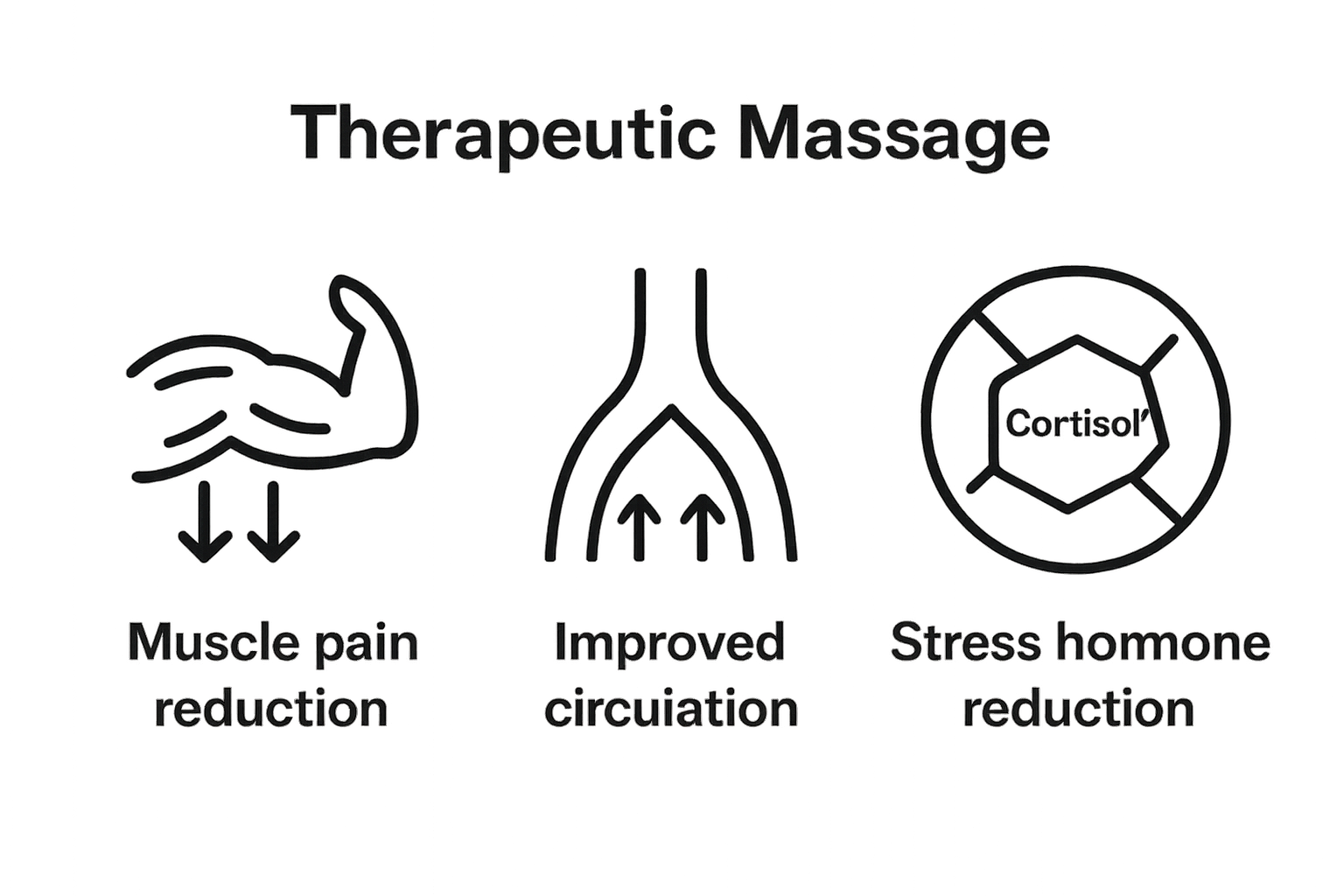Therapeutic massage is more than just a relaxing spa treat. It is a focused health intervention used by millions of Americans every year. People are surprised to learn that over 54% of adults seek massage to help with specific medical and wellness issues instead of just stress relief. Most think of it as simply soothing muscles or calming nerves. The real story is that therapeutic massage acts as a sophisticated tool for targeted healing, tapping into both mind and body in ways few expect.
Table of Contents
Quick Summary
| Takeaway | Explanation |
| Therapeutic massage targets specific health needs. | It focuses on addressing individual physiological and psychological health objectives through professional manipulation of soft tissues. |
| Promotes comprehensive wellness benefits. | This practice enhances circulation, reduces pain, alleviates stress, and supports overall mental and physical well-being. |
| Utilizes specific techniques for effective treatment. | Methods like effleurage, petrissage, and friction are used to treat particular muscle groups and conditions efficiently. |
| Supports injury recovery and pain management. | Therapeutic massage helps in managing chronic pain, rehabilitation post-injury, and alleviating discomfort from various health issues. |
| Integrates mind and body health approaches. | By understanding the interconnectedness of physical and mental health, therapeutic massage promotes holistic healing and balance. |
What is Therapeutic Massage and Its Purpose?
Therapeutic massage represents a targeted, professional approach to healing and wellness through strategic manipulation of soft body tissues. Unlike casual or recreational massage, this specialized technique focuses on addressing specific physiological and psychological health objectives.
Understanding the Core Definition
At its essence, therapeutic massage involves systematic manual manipulation of muscles, connective tissues, tendons, and ligaments to promote healing, reduce pain, and enhance overall physical function. Research from the National Center for Complementary and Integrative Health confirms that this practice goes beyond simple relaxation, serving as a structured intervention for multiple health conditions.
Key characteristics of therapeutic massage include:
-
Precise, intentional techniques targeting specific muscle groups
-
Customized pressure and movement based on individual patient needs
-
Professional assessment of musculoskeletal conditions
-
Scientific understanding of body mechanics and tissue response
Physiological and Psychological Benefits
Therapeutic massage operates on multiple levels, offering comprehensive wellness benefits. Physically, it stimulates blood circulation, reduces muscle tension, and supports the body’s natural healing processes. Psychologically, it helps manage stress, alleviate anxiety, and promote mental relaxation.
The practice involves skilled practitioners understanding human anatomy, applying techniques that can:
-
Reduce chronic pain
-
Improve joint mobility
-
Decrease muscle stiffness
-
Support injury rehabilitation
-
Enhance lymphatic drainage
By integrating both physical manipulation and holistic wellness principles, therapeutic massage provides a nuanced approach to health that addresses interconnected bodily systems.
This table organizes the key physiological and psychological benefits of therapeutic massage, helping readers see how these benefits address different aspects of overall wellness.
| Benefit Type | Example Benefits |
| Physiological | Stimulates blood circulation, reduces muscle tension, supports healing, improves joint mobility, enhances lymphatic drainage |
| Psychological | Manages stress, alleviates anxiety, promotes mental relaxation, improves emotional well-being |
| Long-Term Wellness | Reduces risk of repetitive strain, supports chronic pain management, enhances flexibility and metabolic processes |
 Whether addressing specific medical conditions or supporting general well-being, this technique represents a sophisticated, evidence-based method of promoting healing and balance.
Whether addressing specific medical conditions or supporting general well-being, this technique represents a sophisticated, evidence-based method of promoting healing and balance.
Why Are the Benefits of Therapeutic Massage Important?
Therapeutic massage transcends mere physical comfort, offering profound impacts on overall health and wellness that address both immediate symptoms and long-term physiological balance. Understanding its comprehensive benefits reveals why this practice has become increasingly crucial in modern healthcare strategies.
Holistic Health Restoration
The importance of therapeutic massage lies in its ability to simultaneously address multiple health dimensions. Research from the International Journal of Therapeutic Massage and Bodywork demonstrates that this practice is not simply about temporary relief, but about triggering systemic healing responses within the body.
Key holistic benefits include:
-
Comprehensive stress management
-
Enhanced immune system functionality
-
Improved emotional and mental well-being
-
Natural pain management without pharmaceutical interventions
-
Promotion of body-mind interconnectedness
Physiological Impact and Long-Term Wellness
Therapeutic massage operates as a sophisticated intervention that supports the body’s intrinsic healing mechanisms. By stimulating circulation, reducing inflammation, and releasing muscular tension, it provides a non-invasive approach to health maintenance that can prevent chronic conditions from developing.
Significant physiological benefits encompass:
-
Accelerated muscle recovery
-
Reduced risk of repetitive strain injuries
-
Improved flexibility and range of motion
-
Enhanced metabolic processes
-
Balanced nervous system response
Beyond immediate physical relief, therapeutic massage represents a proactive health strategy. It acknowledges that optimal wellness requires integrated approaches addressing physical, emotional, and systemic health.
 By treating the body as an interconnected system, therapeutic massage offers a nuanced, comprehensive pathway to sustained well-being that empowers individuals to take an active role in their personal health journey.
By treating the body as an interconnected system, therapeutic massage offers a nuanced, comprehensive pathway to sustained well-being that empowers individuals to take an active role in their personal health journey.
How Therapeutic Massage Works on the Body and Mind
Therapeutic massage is a sophisticated interaction between manual manipulation and complex physiological responses, engaging multiple body systems simultaneously to promote healing and balance. This intricate process transforms physical touch into a powerful mechanism for holistic wellness.
Neurological and Physiological Mechanisms
Research from the National Center for Biotechnology Information reveals that therapeutic massage triggers profound neurological responses, activating the parasympathetic nervous system and initiating a cascade of healing processes. When skilled hands apply strategic pressure and movement, the body responds through intricate biochemical and neurological pathways.
Key neurological interactions include:
-
Reduction of cortisol (stress hormone) levels
-
Stimulation of endorphin and serotonin release
-
Modulation of pain perception mechanisms
-
Activation of deep relaxation responses
-
Interruption of chronic stress neurological patterns
Systemic Body Responses
Therapeutic massage transcends surface-level manipulation, engaging multiple physiological systems concurrently. The process stimulates circulation, enhances lymphatic drainage, and supports muscular recovery through precise, intentional techniques.
Significant systemic responses involve:
-
Improved blood and oxygen circulation
-
Enhanced immune system functionality
-
Accelerated metabolic waste removal
-
Reduced muscular tension and inflammation
-
Restoration of natural movement patterns
By understanding these intricate interactions, therapeutic massage emerges as a sophisticated wellness intervention. It demonstrates how intentional, professional touch can recalibrate the body’s complex systems, promoting not just physical healing but comprehensive mind-body restoration. The practice represents a nuanced approach to health that recognizes the profound interconnectedness of physiological and psychological well-being.
Key Concepts Behind Therapeutic Massage Techniques
Therapeutic massage techniques represent a sophisticated blend of scientific understanding, anatomical knowledge, and precise manual skills. These approaches go far beyond simple physical manipulation, embodying a comprehensive strategy for promoting healing and wellness through intentional touch.
Foundational Theoretical Principles
Research from the International Journal of Therapeutic Massage & Bodywork highlights the core theoretical foundations that guide professional massage practice. These principles emphasize understanding human anatomy, biomechanics, and the intricate relationships between different body systems.
Critical theoretical concepts include:
-
Holistic approach to body mechanics
-
Recognition of individual physiological variations
-
Understanding neurological response pathways
-
Biomechanical assessment of tissue conditions
-
Integrative perspective on healing processes
Primary Massage Manipulation Techniques
Professional therapeutic massage incorporates multiple specialized techniques, each designed to address specific physiological objectives. These methods are not random movements but calculated interventions targeting precise anatomical structures and generating specific therapeutic responses.
The following table summarizes the primary therapeutic massage techniques described in the article, highlighting each method’s definition and its main therapeutic goal.
| Technique | Description | Main Therapeutic Goal |
| Effleurage | Gentle, gliding strokes | Promote circulation |
| Petrissage | Kneading movements | Release muscle tension |
| Friction | Deep, circular movements | Target specific muscle groups |
| Tapotement | Rhythmic tapping | Stimulate nerve endings |
| Compression | Sustained pressure | Reduce muscle tension |
Key massage manipulation techniques comprise:
-
Effleurage: gentle gliding strokes to promote circulation
-
Petrissage: kneading movements to release muscle tension
-
Friction: deep circular movements targeting specific muscle groups
-
Tapotement: rhythmic tapping to stimulate nerve endings
-
Compression: sustained pressure to reduce muscle tension
By integrating scientific knowledge with refined manual skills, therapeutic massage techniques represent a nuanced approach to wellness. These methods demonstrate how intentional, expert touch can facilitate profound physiological healing, addressing complex bodily interactions through precise, targeted interventions. The practice embodies a sophisticated understanding of human anatomy, emphasizing the body’s remarkable capacity for self-restoration when skillfully supported.
Real-World Applications and Benefits for Wellness Seekers
Therapeutic massage extends far beyond a luxury experience, serving as a powerful intervention for individuals seeking comprehensive wellness solutions. Its versatile applications address diverse health challenges, making it an essential strategy for proactive personal care and rehabilitation.
Comprehensive Wellness Strategies
Research from the National Center for Complementary and Integrative Health demonstrates that therapeutic massage offers targeted interventions for multiple wellness domains. The practice provides holistic support for individuals managing various physical and emotional health conditions.
Primary wellness applications include:
-
Stress management and emotional regulation
-
Chronic pain mitigation
-
Improved sleep quality
-
Enhanced athletic recovery
-
Supportive care during medical treatments
Targeted Health Condition Management
Therapeutic massage serves as a nuanced intervention for specific health challenges, offering non-invasive support across different population segments. Professional practitioners customize techniques to address individual physiological needs, creating personalized wellness experiences.
Specific health condition management strategies encompass:
-
Fibromyalgia symptom reduction
-
Pregnancy-related discomfort alleviation
-
Rehabilitation after sports injuries
-
Tension headache and migraine management
-
Postural alignment and muscular imbalance correction
By integrating scientific understanding with personalized care, therapeutic massage emerges as a sophisticated wellness tool. It transcends traditional treatment models, offering a holistic approach that empowers individuals to actively participate in their health journey. The practice represents a dynamic intersection of medical knowledge, manual skill, and compassionate care, demonstrating how intentional touch can facilitate profound physiological and emotional healing.
Experience the Transformative Power of Therapeutic Massage in Toronto
Are you searching for more than temporary relief from stress, tension, or chronic pain? As explored in our article on the benefits of therapeutic massage, many people struggle with ongoing muscle discomfort, sleep issues, and the need for genuine mind-body balance. The science behind therapeutic massage shows it goes beyond simple relaxation, offering real improvement in circulation, nerve function, and emotional well-being. You deserve a carefully tailored solution that addresses both physical and mental obstacles to feeling your best.

Imagine what personalized care from seasoned Registered Massage Therapists could do for your body and mind. At Verdure Registered Massage Therapy, our skilled team delivers proven techniques like Swedish massage, deep tissue massage, myofascial release, and pregnancy support therapies, all designed to relieve your unique pain points. Now is the ideal time to take your next step toward lasting change. Visit Verdure Registered Massage Therapy to explore our full range of holistic services and book your session today. Lasting wellness is a choice you can make right now.
Frequently Asked Questions
What is therapeutic massage?
Therapeutic massage is a specialized technique that involves the systematic manipulation of soft body tissues, targeting specific physiological and psychological health objectives to promote healing and overall well-being.
What are the main benefits of therapeutic massage?
The primary benefits include stress management, pain reduction, improved joint mobility, enhanced blood circulation, and support for injury rehabilitation, among others.
How does therapeutic massage affect the body and mind?
Therapeutic massage activates the parasympathetic nervous system, reduces stress hormone levels, promotes relaxation, and stimulates the release of feel-good hormones like endorphins, impacting both physical and mental health positively.
What techniques are used in therapeutic massage?
Common techniques include effleurage (gliding strokes), petrissage (kneading), friction (deep circular movements), tapotement (rhythmic tapping), and compression (sustained pressure), each designed for specific therapeutic outcomes.
